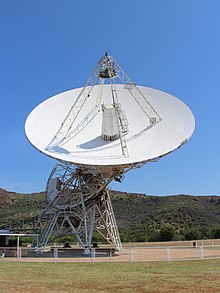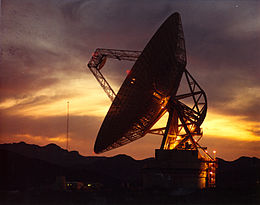Radio astronomy
The radio astronomy is that branch of astronomy in which astronomical objects by means of the radiation emitted by them radio waves are investigated.
Frequency range
The frequency range of radio astronomy is limited by the earth's atmosphere . Below a frequency of 10 MHz it is impermeable to radio waves because the ionosphere reflects radio waves of lower frequencies. Above 100 GHz, radio waves are absorbed by water and other molecules in the air, making it difficult to receive higher frequency radio waves. The range from 10 MHz to 100 GHz most used for radio astronomy - corresponding to the wavelength range from 30 m to 3 mm - is known as the astronomical or radio window.
Cosmic radio astronomy
Because of the great distance of the astronomical radio sources, their radio waves received on earth have a very low intensity. Radio astronomy therefore needs large antennas to bundle them. The types are depending on the wavelength z. B. Yagi antennas , frame , helix and parabolic antennas . The radio waves are processed by sensitive amplifiers and then electronically stored and evaluated.
A certain measured value indicates the intensity with which the radio waves arrive from the direction at which the radio telescope is directed. A “look” through a radio telescope does not yet produce a radio image, but only a single radio image point.
The wavelength of radio waves is much larger than the wavelength of visible light, which is why the angular resolution of a single radio telescope is much worse than that of an optical telescope . As a result, a radio telescope image composed of many measurements is much more blurred than an image of the same object in visible light. There are, however, methods of obtaining high-resolution radio images of extensive astronomical objects. For example, several radio telescopes can be connected together to form an interferometer so that they act like a single radio telescope, the antenna diameter of which corresponds to the distance between the individual systems. Since the resolution depends on the distance between the antennas, you can even achieve sharper images than with optical telescopes.
Because radio waves are less absorbed than light by intergalactic clouds of dust and fog , and since most galactic celestial bodies are only weak radio sources, radio waves can be used to explore areas such as the center of the Milky Way or dwarf galaxies behind the galactic disk using optical or infrared Observation remain closed.
Some of the most important spectral lines in astronomy lie in the radio wave range, including the HI line (21 cm line, 1420.4058 MHz), which is emitted by neutral hydrogen atoms .
Radio astronomy examines the following radio sources, among others:
- the sun and other bodies in the solar system
- Supernova remnants and pulsars
- interstellar gases and gas nebulae
- the galactic center of the Milky Way
- Radio galaxies
- Quasars
The technique of radio astronomy is also used to search for extraterrestrial intelligences ( SETI ).
The history of radio astronomy
In 1930 Karl Guthe Jansky looked for the cause of a disruption in a newly opened transatlantic radio link at a wavelength of 15 meters (20 MHz). For this he built an antenna that was 30 m wide and 4 m high. It consisted of brass pipes and wood and rotated every 20 minutes on wheels of an old Model T Ford . In 1932 he determined that the signal reached its maximum every sidereal day instead of every sunny day and thus excluded the sun as a source from which he did not detect any signal. He determined the direction at a right ascension of 18 h and a declination of 10 °, with a high degree of uncertainty in the declination. This was the first time he was able to detect radio waves from a radio source outside our solar system . He suspected the source of the galactic center (this is about 40 ° further south) or the sun apex , the point towards which the sun moves on its orbit around the galactic center .
The unit used in radio astronomy was
introduced in his honor .
Grote Reber read Jansky's publications on cosmic radio waves and tried to detect them at higher frequencies. He built a parabolic antenna with a diameter of 9.5 m in his garden. At frequencies of 3.3 GHz and 910 MHz, he could not detect any emissions from the direction of the galactic center, an indication that the source could not be a thermal cavity radiator . He was able to detect the source in the galactic center at 160 MHz. He scanned the radio sky at 160 and 480 MHz and found the strongest source in the galactic center, but found other areas of high intensity that did not seem to coincide with bright astronomical light sources, which later with the supernova remnants Cassiopeia A , the Vela pulsar and the active galaxy Cygnus A are identified. He proposed bremsstrahlung as the mechanism of formation of cosmic radio waves, the intensity of which decreases with frequency .
Sub-areas and research objects of radio astronomy
Objects in the solar system
- The solar radio astronomy deals with the sun emitted radio waves. These give z. B. Information about solar activity and radiation bursts on the sun.
- The planets , especially the gas giants, and their moons emit radio waves.
Objects in the Milky Way
Objects outside the Milky Way
Collision with other radio services

Radio astronomy analyzes extremely weak signals. Received signal strengths of only −260 dBm are not uncommon. As a result, other radio services can easily cover up or interfere with all signals of interest to radio astronomy, so that evaluation is no longer possible. In principle, it is subject to regulation by the VO Funk . From this, among other things, protection zones in the vicinity of radio astronomical facilities can be derived.
The radio astronomy service is declared by the ITU as a "passive service", to which spectra are assigned as well as all other radio users. However, these allocated bands are relatively limited and are always in the interests of other radio services and must therefore be defended within the framework of regulatory processes. Radio astronomers also use spectral ranges that are reserved for active radio services, but are seldom used or used with local restrictions. The growing hunger of the economy for bands for active radio services such as data networks and telecommunications, however, restricts the use of radio astronomy more and more in the non-reserved bands. In the reserved bands, on the other hand, radio astronomers are confronted with increasing unwanted interference from faulty transceivers and poorly constructed transmitters. The total number of malfunctions is increasing worldwide.
But since radio astronomy is interested in ever weaker signals from space in order to e.g. For example, being able to prove the presence of organic molecules, experts speak of a closing window into space. More and more frequency ranges can no longer be used, or the strategies for recognizing interference and removing it from the useful signal are becoming more and more complex.
Some particularly critical scientists see a telescope station on the opposite side of the moon as the only possibility for permanent exploration of distant parts of space.
Important radio observatories
- FAST observatory
- IRAM 30 m
- Very large array
- Zelenchukskaya
- Westerbork
- Arecibo
- Jodrell Bank
- Astropeiler Stockert
- Effelsberg radio telescope
- Large millimeter telescope
See also
- List of radio telescopes and research stations
- Terahertz radiation
- Amateur radio astronomy
- Radio JOVE
- Multi-wavelength astronomy
- Observational Astronomy
- ALMA
literature
- Bernard F. Burke, Francis Graham-Smith: An introduction to radio astronomy. Cambridge Univ. Press, Cambridge 2010. ISBN 978-0-521-87808-1
- Kristen Rohlfs, TL Wilson et al. a .: Tools of radio astronomy. Springer, Berlin 2009. ISBN 3-540-85121-6
- AR Taylor: Radio emission from the stars and the sun. Astronomical Soc. of the Pacific, San Francisco 1996. ISBN 1-886733-14-7
- James S. Hey: The radio universe. Pergamon Pr., Oxford 1971, ISBN 0-08-015741-6 ; German: The radio universe - introduction to radio astronomy. Verl. Chemie, Weinheim 1974, ISBN 3-527-25563-X .
- Peter Lay: Signals from space - simple experiments on receiving extraterrestrial radio signals. Franzis, Poing 2001. ISBN 3-7723-5925-6
- Jim Cohen (et al.): CRAF Handbook for Radio Astronomy , Third edition - 2005 (PDF file; 173 p .; accessed October 20, 2009; 1.2 MB)
- David Leverington: Encyclopedia of the history of astronomy and astrophysics. Cambridge Univ. Press, Cambridge 2013. ISBN 978-0-521-89994-9
- James J. Condon, Scott M. Ransom: Essential Radio Astronomy. Princeton University Press, Princeton 2016, ISBN 9780691137797 .
Web links
- Is there astronomy without a telescope? from the alpha-Centauri television series(approx. 15 minutes). First broadcast on Nov 25, 2001.
- Essential Radio Astronomy , National Radio Astronomy Observatory
- Basics of Radio Astronomy , JPL 1998
- Astrophysical Institute Potsdam (AIP)
- Atacama Pathfinder EXperiment APEX
Individual evidence
- ↑ Administrative regulations for frequency assignments in non-public mobile land radio. (No longer available online.) Federal Network Agency, archived from the original on January 29, 2016 ; accessed on January 29, 2016 . Info: The archive link was inserted automatically and has not yet been checked. Please check the original and archive link according to the instructions and then remove this notice.

